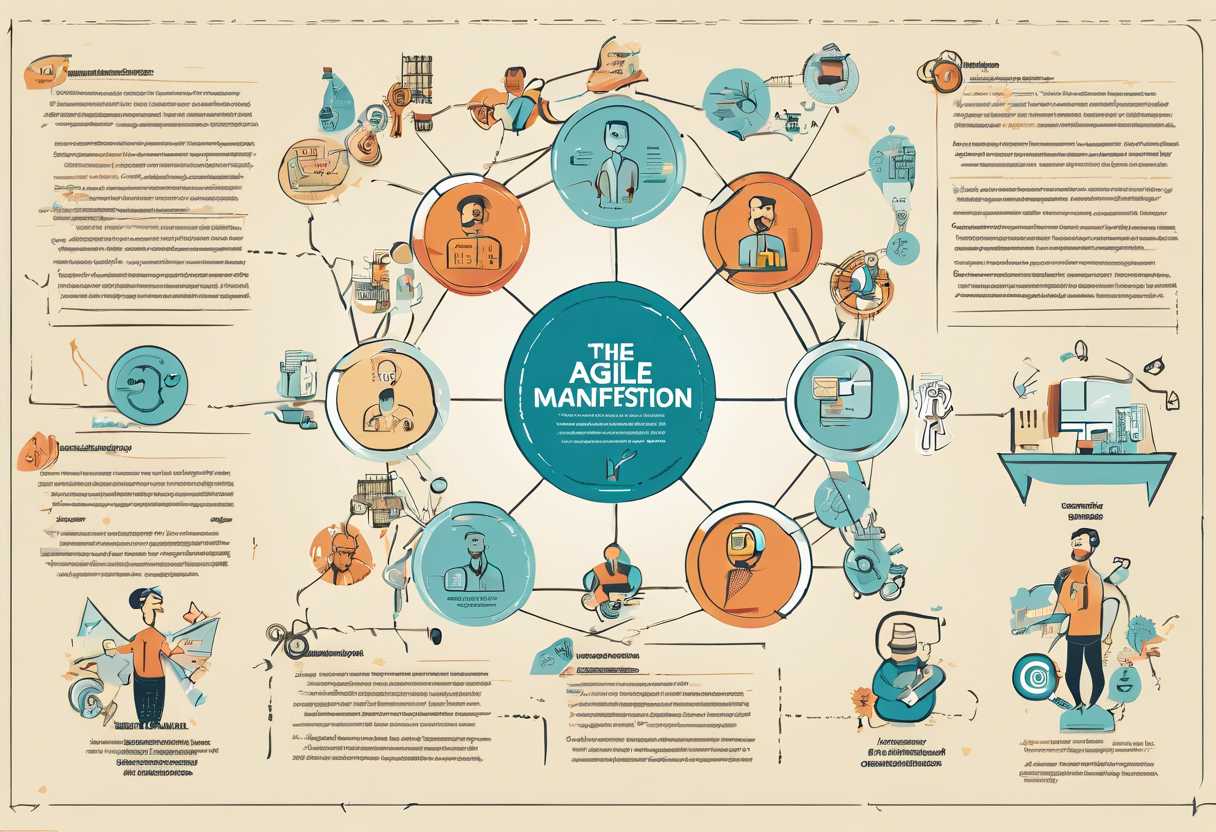The Agile Manifesto, a pivotal document in the world of software development, was created in response to the need for a more flexible and collaborative approach to project management. In this blog post, we will delve into the origins of the Agile Manifesto, providing a historical overview of its creation. We will also explore the context that led to the emergence of Agile, shedding light on the key contributors and influences behind its inception. Additionally, we will examine the core principles and values of the Agile Manifesto, as well as its impact and evolution in today’s business environment. Join us as we unravel the when and why behind the creation of the Agile Manifesto, and gain a deeper understanding of its significance in the modern world of project management.
The Origins of the Agile Manifesto: A Historical Overview
The Birth of Agile
The Agile Manifesto, a groundbreaking document that revolutionized the software development industry, was born out of a meeting of 17 software developers in 2001. Frustrated with the traditional, rigid methodologies of software development, these individuals came together to discuss a new approach that would prioritize flexibility, collaboration, and customer satisfaction. This meeting led to the creation of the Agile Manifesto, which outlined the core values and principles of the Agile methodology.
The Core Values of Agile
The Agile Manifesto is built upon four core values: individuals and interactions over processes and tools, working software over comprehensive documentation, customer collaboration over contract negotiation, and responding to change over following a plan. These values emphasize the importance of people and their interactions, the delivery of functional software, customer involvement, and adaptability. These values have since become the guiding principles for Agile development teams around the world.
The Principles of Agile
In addition to the core values, the Agile Manifesto also includes 12 principles that further define the Agile approach to software development. These principles emphasize customer satisfaction, embracing change, delivering working software frequently, and fostering a collaborative and motivated team. By adhering to these principles, Agile teams are able to respond to customer needs more effectively and deliver high-quality software in a timely manner.

Understanding the Need for Agile: The Context of its Creation
The Evolution of Agile Methodology
Agile methodology has become increasingly popular in the software development industry due to its ability to adapt to changing requirements and deliver high-quality products in a timely manner. The need for Agile arose from the limitations of traditional waterfall methods, which often resulted in delayed projects and unsatisfied customers. As technology and business environments continue to evolve, the need for a more flexible and collaborative approach to project management has become essential.
Adapting to Changing Business Environments
One of the key reasons for the creation of Agile methodology was the need to adapt to rapidly changing business environments. Traditional project management methods were often unable to keep up with the pace of change, leading to outdated and irrelevant deliverables. Agile’s iterative and incremental approach allows teams to respond quickly to changes in requirements, market conditions, and customer feedback, ensuring that the end product meets the current needs of the business.
Collaboration and Communication
Another driving force behind the creation of Agile was the need for improved collaboration and communication within project teams. Traditional methods often resulted in siloed work environments, where team members had limited interaction and visibility into each other’s progress. Agile promotes a culture of collaboration, with regular meetings, open communication channels, and a focus on teamwork. This shift in mindset has proven to be essential in delivering successful projects that meet the needs of all stakeholders.

The Key Contributors and Influences Behind the Agile Manifesto
The Founding Fathers of Agile
When it comes to the Agile Manifesto, there are a few key individuals who are considered the founding fathers of this revolutionary approach to software development. These individuals include:
- Kent Beck: Known for his creation of Extreme Programming (XP), Beck is a software engineer and author who has been a major influence in the Agile movement.
- Jeff Sutherland: Co-creator of the Scrum framework, Sutherland has been a driving force behind the widespread adoption of Agile methodologies.
- Ward Cunningham: The inventor of the wiki and a pioneer in the field of software design patterns, Cunningham’s contributions to Agile cannot be overstated.
Influences on the Agile Manifesto
While the founding fathers of Agile played a crucial role in shaping the movement, there were also several key influences that helped to shape the Agile Manifesto. These influences include:
- Lean Manufacturing: The principles of Lean Manufacturing, which focus on eliminating waste and maximizing value, heavily influenced the Agile approach to software development.
- Adaptive Software Development: Jim Highsmith’s Adaptive Software Development methodology, which emphasizes collaboration and flexibility, provided a framework for many Agile practices.
- Feature-Driven Development: Developed by Jeff De Luca, Feature-Driven Development’s focus on delivering tangible, working software in short iterations aligns closely with Agile principles.
The Core Principles and Values of the Agile Manifesto
Principles of the Agile Manifesto
The Agile Manifesto is based on twelve principles that guide the Agile methodology. These principles emphasize customer satisfaction, collaboration, and flexibility. One of the key principles is customer satisfaction through early and continuous delivery of valuable software. This means that Agile teams prioritize delivering working software to customers as early and as frequently as possible, allowing for feedback and adjustments along the way.
Another important principle is welcoming changing requirements, even late in development. This principle acknowledges that change is inevitable and encourages Agile teams to embrace change rather than resist it. By being adaptable and responsive to change, Agile teams can better meet the needs of their customers.
Values of the Agile Manifesto
The Agile Manifesto is built on four core values: individuals and interactions over processes and tools, working software over comprehensive documentation, customer collaboration over contract negotiation, and responding to change over following a plan. These values prioritize people and their interactions, the delivery of working software, collaboration with customers, and adaptability.
By prioritizing individuals and interactions, Agile teams focus on the human aspect of software development, fostering collaboration and communication. This leads to a more effective and efficient development process. Additionally, the emphasis on working software over documentation ensures that the primary focus is on delivering value to the customer through functional software.
Benefits of Embracing Agile Principles and Values
Embracing the principles and values of the Agile Manifesto can lead to numerous benefits for organizations. These include increased customer satisfaction through early and frequent delivery of valuable software, improved adaptability to changing requirements, and enhanced collaboration with customers and within development teams. By prioritizing these core principles and values, organizations can achieve greater success in their software development efforts.
The Impact and Evolution of the Agile Manifesto in Today’s Business Environment
Agile Manifesto: A Brief Overview
The Agile Manifesto, created in 2001, has had a profound impact on the way businesses operate. It emphasizes individuals and interactions over processes and tools, working software over comprehensive documentation, customer collaboration over contract negotiation, and responding to change over following a plan. This shift in mindset has revolutionized the way businesses approach project management and product development.
Agile in Today’s Business Environment
In today’s fast-paced and ever-changing business environment, the principles of the Agile Manifesto have become even more relevant. With the rise of digital transformation and the need for rapid innovation, businesses are turning to Agile methodologies to stay competitive. Agile allows for greater flexibility, adaptability, and customer-centricity, enabling companies to deliver value to their customers more efficiently.
The Evolution of Agile
While the core principles of the Agile Manifesto remain unchanged, the application of Agile has evolved over the years. New frameworks and methodologies, such as Scrum, Kanban, and Lean, have emerged to provide more specific guidelines for implementing Agile practices. Additionally, Agile has expanded beyond its origins in software development and is now being adopted in various industries, including marketing, HR, and finance.
Conclusion
As we have explored in this blog post, the Agile Manifesto was created in response to the need for a more flexible and collaborative approach to software development. The historical overview of its origins sheds light on the context in which it was born, and the key contributors and influences behind its creation have played a pivotal role in shaping its core principles and values.
Today, the Agile Manifesto continues to have a profound impact on the business environment, driving innovation, adaptability, and customer-centricity. Its evolution has led to the widespread adoption of agile methodologies across various industries, revolutionizing the way teams work and deliver value to their customers.
As we navigate the ever-changing landscape of business and technology, it is essential to embrace the principles and values of the Agile Manifesto to stay competitive and responsive to market demands. By fostering a culture of collaboration, continuous improvement, and customer satisfaction, organizations can harness the power of agility to drive success in the digital age.
Whether you are a seasoned agile practitioner or new to the concept, understanding the origins, context, and impact of the Agile Manifesto is crucial for driving meaningful change within your organization. Embrace agility, and embark on a journey of transformation that will propel your business towards a brighter and more prosperous future.
Thank you for joining us on this exploration of the Agile Manifesto. We hope that the insights shared in this blog post have inspired you to embrace agility and drive positive change within your organization. Stay tuned for more valuable content on agile methodologies and best practices.

